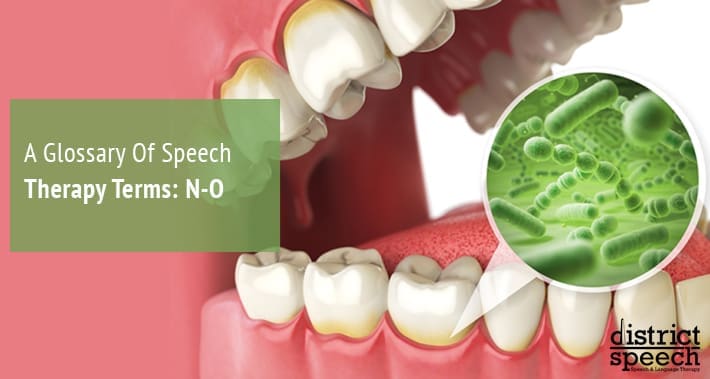
One of the most important aspects to any type of therapy is understanding the terminology used by your speech therapist.
This holds especially true for speech therapy.
Understanding the terms that your speech therapist uses to describe your health and progress can help you get as much value out of your therapy as possible.
For instance, knowing that your therapist is referring to the roof of your mouth when they reference your “palate” can help you better understand the information and health care advice they give you.
We’re District Speech, a Washington DC speech therapist with a passion for patient education.
That’s why we’ve put together a series of articles to help you better understand your health and therapy progress.
In the last two articles – Speech Therapy Terms: F-M and Speech Therapy Terms: A-E, we looked at speech therapist terms from the beginning of the alphabet.
This article will look at speech therapy from N-O.
You can also continue to the next articles in the series – Speech Therapy Terms: P-R and Speech Therapy Terms: S-Z.
Let’s get started.
Nasal Emission
Nasal emission refers to the sound of airflow passing through the nose during speech, typically due a gap between the nasal and oral cavities.
Your nasal and oral cavities work closely together.
Typically, they are separated by a section of the roof of your mouth known as the soft palate.
Occasionally, the soft palate fails to form as expected during development and instead forms a gap through which nasal emission occurs.
This gap can be caused by a variety of reasons but is most often seen in people with cleft palate.
Nasality
Nasality is a term used to describe a general symptom of excess nasal components during speech.
Someone speaking with excess nasality often sound as if they have too much or too little air in their nose, hence the term “nasality”.
As it’s a general symptom, nasality may present as a symptom of multiple conditions and disorders, such as cleft palate or a nasal obstruction.
Negation
Negation refers to the words used during conversation to signify a denial or refusal.
For instance, “no” and “not” are both examples of negation.
Young children often use simple negation, such as saying “no”.
However, other types of more advanced negation, such as “isn’t” or “wasn’t” can be challenging for your young child to understand.
If your child is struggling to understand or correctly use negation, try setting aside a few minutes everyday to practise or speak to a speech therapist.
Object Permanence
If you’ve ever watched a video of a cat being startled by something that’s been placed out of sight behind them, you’re already well on your way to understanding object permanence.
Object permanence is the ability to understand that something still exists even when it’s been removed from sight.
Babies are born without an understanding of object permanence.
That’s why they have so much fun playing peekaboo!
It typically starts to develop around two years of age; however, certain conditions and disorders may interfere with this development, such as attention deficit hyperactivity disorder (ADHD).
Occlusion
Occlusion refers to the relationship between the various surfaces of your upper and lower teeth.
A term often heard in dentistry, occlusion may be used to describe multiple “bites”, or ways that your teeth form together as your mouth closes, such as an underbite (malocclusion), overbite, cross bite, or open bite.
The presence of these types of occlusions can lead to speech and language difficulties, such as lisps or other speech impediments.

Oral Cavity
Your oral cavity is your mouth.
It includes a variety of parts, including:
- Your lips
- The lining inside your lips and cheeks
- The front of your tongue
- Under your tongue
- Your upper and lower gums
- The floor of your mouth
- The roof of your mouth
- The small area behind your wisdom teeth
Any issues with any of these parts can potentially lead to a speech and language disorder.
Be sure to speak with your child’s pediatrician if you suspect an abnormality with their oral cavity development.
Oral Peripheral Examination
During assessment, your speech therapist will conduct a series of evaluations to test for any issues impacting your speech and language skills.
The oral peripheral examination, also known simply as oral motor examination, is one such evaluation.
Oral peripheral examinations help your speech therapist assess your mouth for structural and functional abnormalities as they relate to your speech, chewing, and swallowing.
Additionally, oral peripheral examinations help your speech therapist test your mouth’s range of motion, coordination, and strength.
Book Your Appointment With District Speech Today
Are you interested in hearing more about speech therapy terms and how they relate to your personal health?
At District Speech, our team is committed to making sure you understand exactly what’s going on with your speech and language help.
Don’t hesitate to give us a call with any questions to book an appointment.
Book your appointment with District Speech today to get started with your speech and language transformation.
1300 I St NW, #400E,
Washington, DC 20005
- https://g.page/districtspeech
District Speech and Language Therapy specializes in speech therapy, physical therapy, and occupational therapy solutions, for both children and adults, in the Washington D.C and the Arlington Virginia areas.